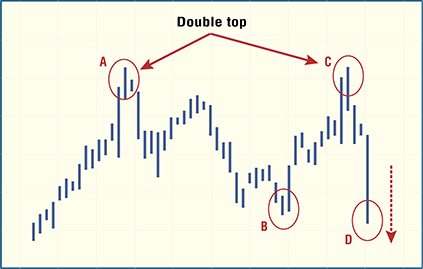Novice Traders’ Notebook
Cardinal Reversal Patterns — At Tops
1. The Double Top
Consider a security or a futures contract that is in an uptrend. The price reaches a point at which all of the buyers' demand is met, and the sellers, whether traders taking profits or aggressive short sellers, enter the market and overwhelm the buyers. That price level will become known as major resistance, as the level establishes a point at which the supply is significantly greater than the demand (point A).

Frequently, the volume of trading activity at this level will increase dramatically. The inability of the market to sustain the uptrend attracts further profit-taking; at that point, the market undergoes a corrective phase (B). However, the fundamentals underlying the bull market may not have reversed course as yet, and so, the news begins to turn positive and the bullish trend reasserts itself.
But sitting on the sidelines are traders and investors recalling the recent highs. They are quietly contemplating that if the opportunity to sell at the highs that they saw before presents itself again, they will take it.
As the market rallies back to major resistance, the sellers take this opportunity to offer their shares to the last buyers of the bull market (C). Once the latecomers have bought their shares, the market begins to decline; the sellers have taken control after unloading their holdings. Usually, this second test of major resistance will have noticeably less volume than the first, as the buyers are few and the sellers are relieved that they have made use of the second selling opportunity. Then, the market declines and breaks below the lows established between the two peaks. This signals to the technicians that the double top is complete (D).